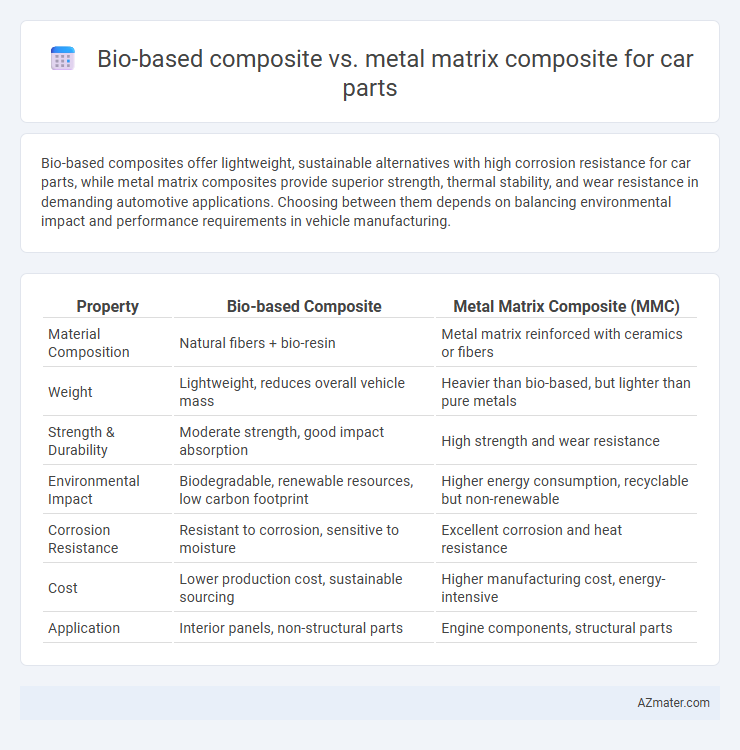Bio-based composites offer lightweight, sustainable alternatives with high corrosion resistance for car parts, while metal matrix composites provide superior strength, thermal stability, and wear resistance in demanding automotive applications. Choosing between them depends on balancing environmental impact and performance requirements in vehicle manufacturing.
Table of Comparison
| Property | Bio-based Composite | Metal Matrix Composite (MMC) |
|---|---|---|
| Material Composition | Natural fibers + bio-resin | Metal matrix reinforced with ceramics or fibers |
| Weight | Lightweight, reduces overall vehicle mass | Heavier than bio-based, but lighter than pure metals |
| Strength & Durability | Moderate strength, good impact absorption | High strength and wear resistance |
| Environmental Impact | Biodegradable, renewable resources, low carbon footprint | Higher energy consumption, recyclable but non-renewable |
| Corrosion Resistance | Resistant to corrosion, sensitive to moisture | Excellent corrosion and heat resistance |
| Cost | Lower production cost, sustainable sourcing | Higher manufacturing cost, energy-intensive |
| Application | Interior panels, non-structural parts | Engine components, structural parts |
Introduction to Automotive Composite Materials
Automotive composite materials enhance vehicle performance by reducing weight while maintaining strength and durability. Bio-based composites utilize renewable natural fibers like flax or hemp combined with polymer matrices, offering sustainable alternatives with lower environmental impact compared to traditional metal matrix composites. Metal matrix composites, reinforced with materials such as silicon carbide or alumina, deliver superior thermal conductivity and mechanical properties but often at higher cost and weight.
Overview of Bio-based Composites
Bio-based composites for car parts utilize natural fibers such as flax, hemp, or kenaf combined with biodegradable polymers, promoting sustainability and reducing environmental impact. These composites offer advantages like lightweight properties, corrosion resistance, and improved recyclability compared to metal matrix composites. While metal matrix composites provide superior strength and thermal stability, bio-based composites excel in eco-friendliness and cost-effectiveness for non-structural automotive components.
Fundamentals of Metal Matrix Composites
Metal Matrix Composites (MMCs) consist of a metal alloy matrix reinforced with ceramic or metallic fibers and particles, offering superior strength, stiffness, and thermal resistance compared to bio-based composites. MMCs are predominantly used in automotive parts requiring high wear resistance and load-bearing capacity, such as brake rotors and engine components, due to their excellent mechanical properties and thermal stability. In contrast, bio-based composites typically exhibit lower density and environmental impact but lack the high-temperature performance and durability characteristic of MMCs in demanding automotive applications.
Mechanical Properties: Bio-based vs Metal Matrix
Bio-based composites generally offer lower density and improved impact resistance, making them lightweight alternatives for car parts, but they typically exhibit reduced tensile strength and stiffness compared to metal matrix composites (MMCs). Metal matrix composites provide superior mechanical properties, including higher tensile strength, hardness, and thermal stability, which are critical for load-bearing and high-temperature automotive applications. While bio-based composites excel in sustainability and corrosion resistance, MMCs dominate in performance-demanding environments requiring enhanced wear resistance and structural integrity.
Weight Reduction and Fuel Efficiency
Bio-based composites offer significant weight reduction compared to traditional metal matrix composites, resulting in lower vehicle mass and improved fuel efficiency. Metal matrix composites provide superior strength and thermal stability but tend to be heavier, which can increase fuel consumption. Incorporating bio-based composites in car parts enhances sustainability and energy savings by reducing overall vehicle weight and emissions.
Environmental Impact and Sustainability
Bio-based composites for car parts significantly reduce carbon emissions and reliance on non-renewable resources compared to metal matrix composites (MMCs), which typically involve energy-intensive extraction and processing. The biodegradability and recyclability of bio-based composites enhance sustainability profiles, while MMCs offer superior mechanical properties but pose challenges in end-of-life disposal and resource recovery. Lifecycle assessments show bio-based composites contribute to lower environmental impacts, positioning them as a greener alternative for automotive manufacturing focused on sustainability goals.
Cost Comparison and Manufacturing Considerations
Bio-based composites generally offer lower material and processing costs compared to metal matrix composites (MMCs) due to the use of renewable resources and simpler manufacturing techniques such as compression molding or injection molding. MMCs require high-temperature processing and specialized equipment, driving up energy consumption and production expenses, which impacts overall cost efficiency in automotive part manufacturing. However, bio-based composites may present challenges in mechanical performance and durability, while MMCs provide superior strength and thermal resistance, influencing manufacturing decisions based on cost-performance trade-offs.
Applications in Car Part Production
Bio-based composites are increasingly used in car part production for interior panels, door trims, and seat components due to their lightweight nature and environmental benefits, enhancing fuel efficiency and sustainability. Metal matrix composites excel in high-performance applications such as engine components, brake rotors, and suspension parts by offering superior strength, thermal conductivity, and wear resistance. The choice between bio-based and metal matrix composites depends on the specific performance requirements and weight reduction goals in automotive manufacturing.
Durability and Life Cycle Performance
Bio-based composites for car parts offer improved sustainability with lower environmental impact and competitive durability under moderate stress conditions, making them ideal for non-structural components. Metal matrix composites (MMCs) provide superior strength, wear resistance, and thermal stability, enhancing life cycle performance in high-stress environments such as engine and brake components. Comparative studies indicate MMCs outperform bio-based composites in long-term durability and fatigue resistance, though bio-based composites excel in reducing vehicle weight and carbon footprint over the product lifecycle.
Future Trends in Composite Materials for Automobiles
Bio-based composites and metal matrix composites (MMCs) both exhibit promising future trends in automotive applications, with bio-based composites gaining momentum due to their sustainability, lightweight nature, and reduced carbon footprint. MMCs continue to advance through enhanced mechanical properties and thermal stability, making them ideal for high-performance engine components and structural parts. The integration of nano-reinforcements and hybrid composite structures is expected to optimize strength-to-weight ratios, improve fuel efficiency, and support the automotive industry's shift toward eco-friendly, high-strength materials.

Infographic: Bio-based composite vs Metal matrix composite for Car part
 azmater.com
azmater.com